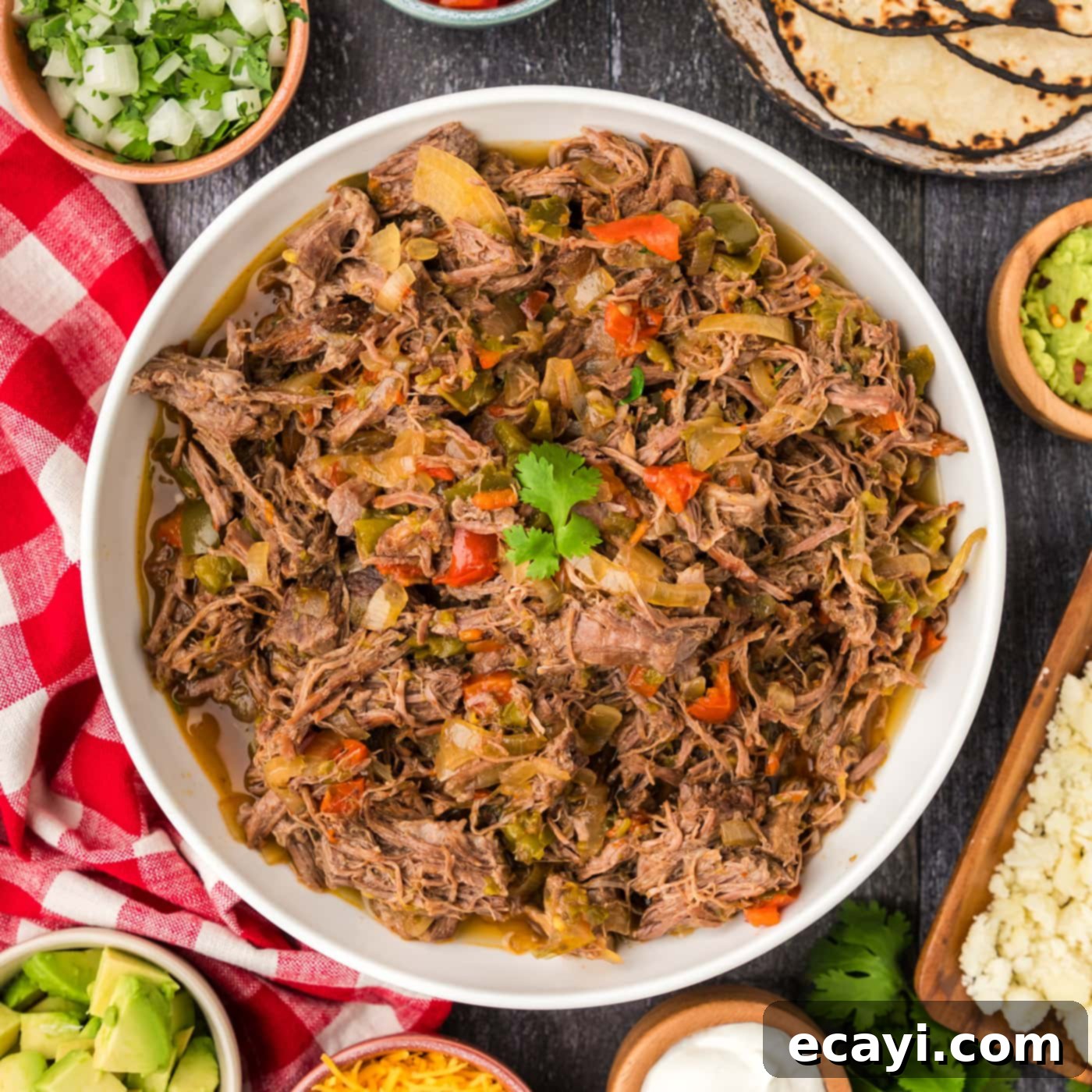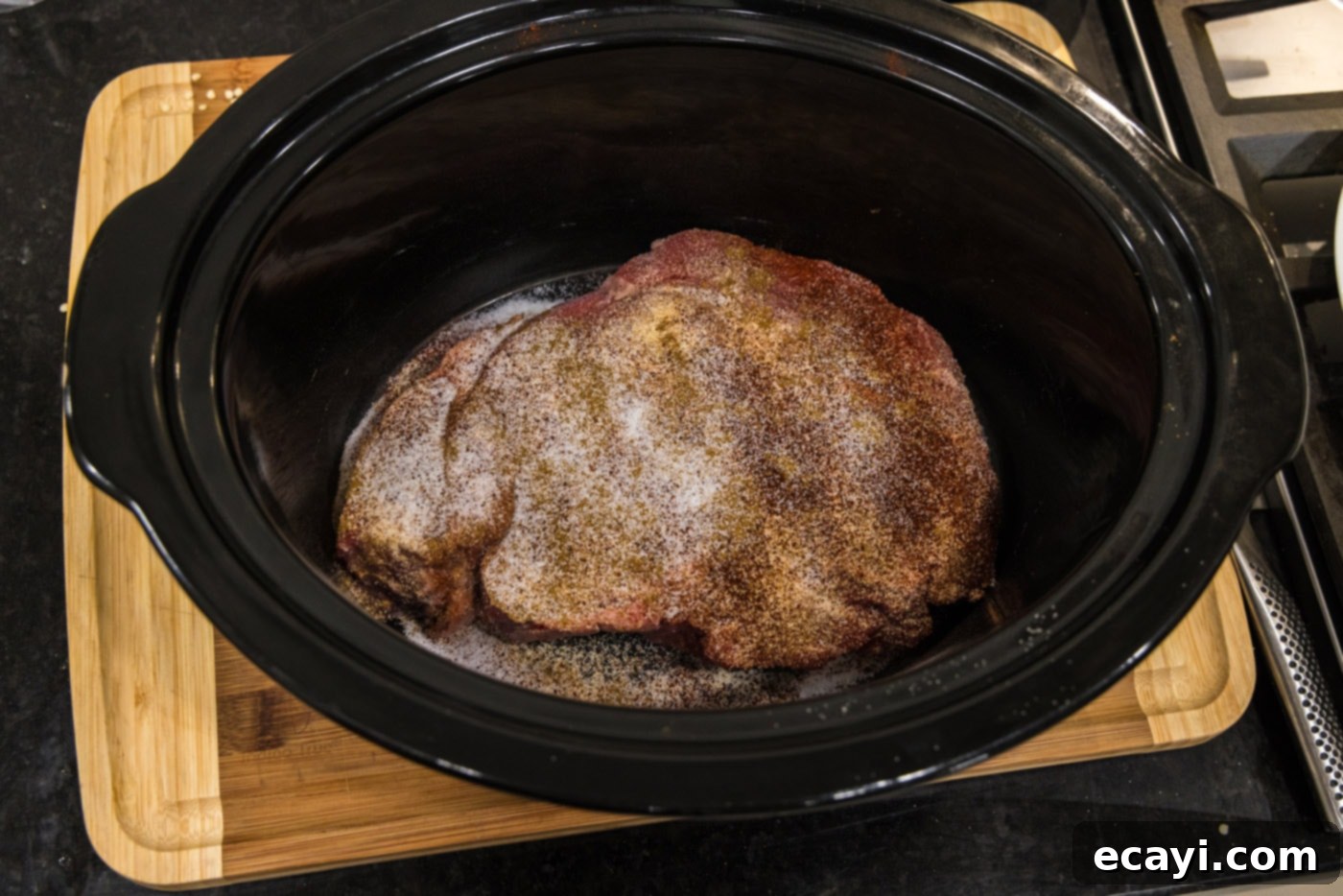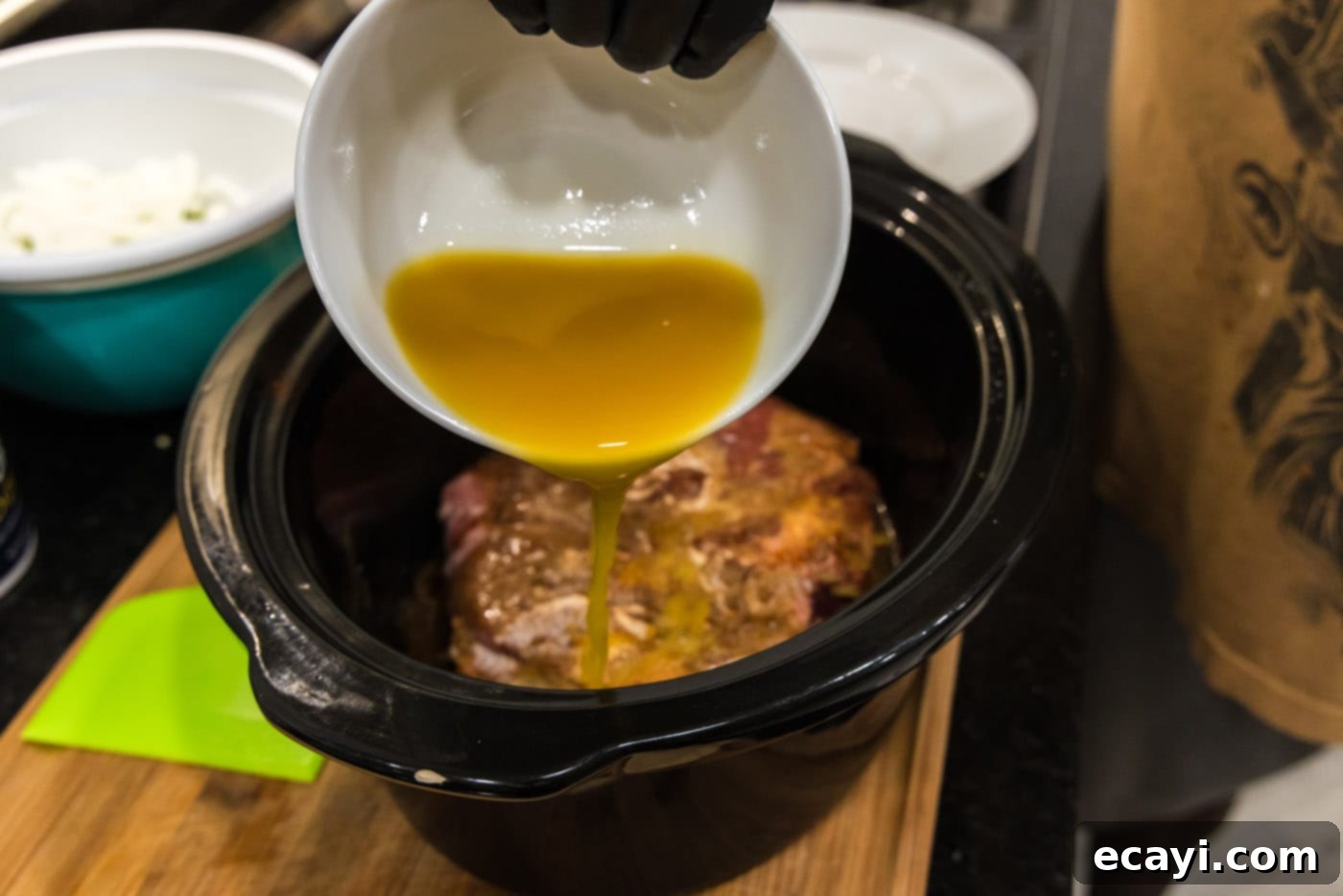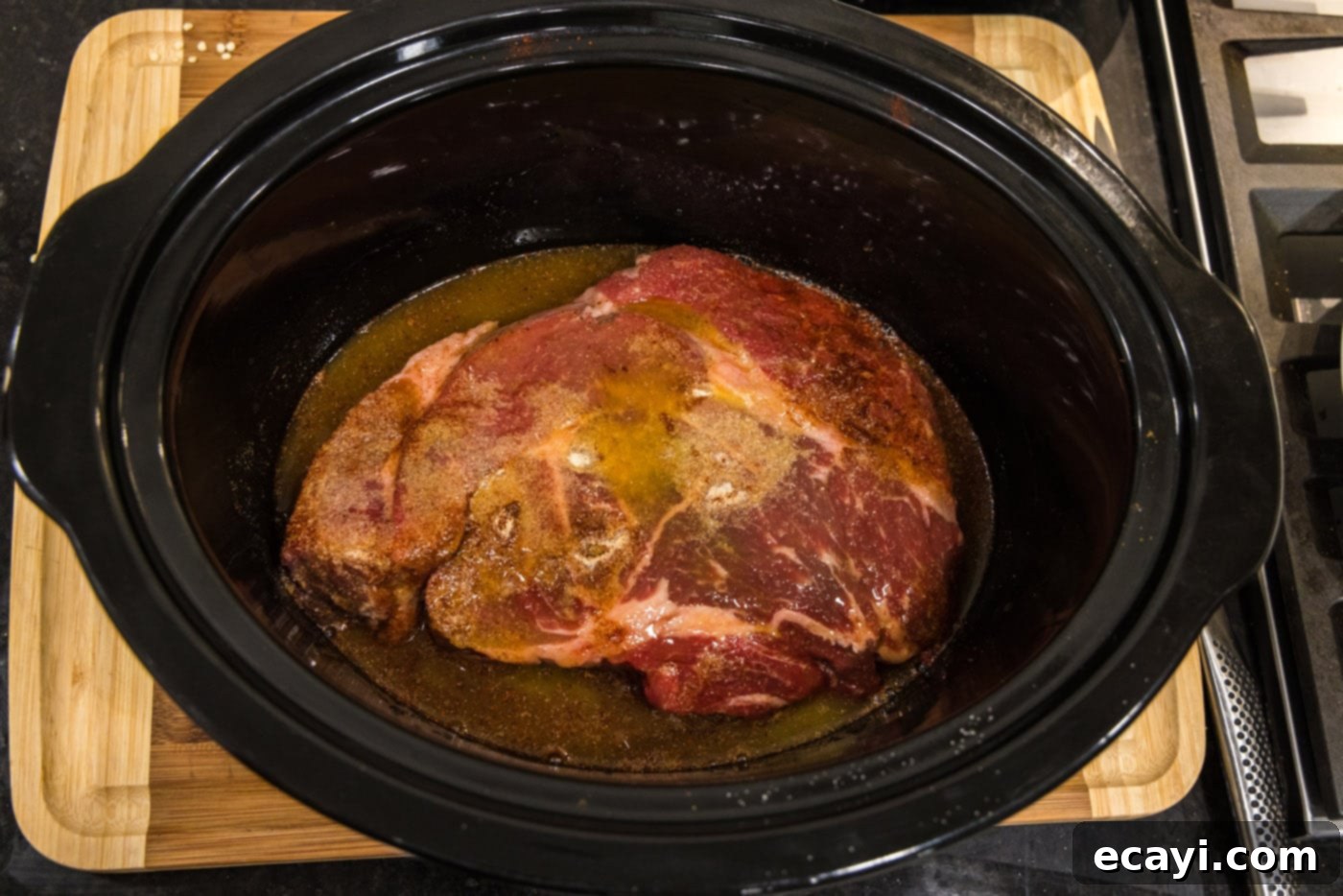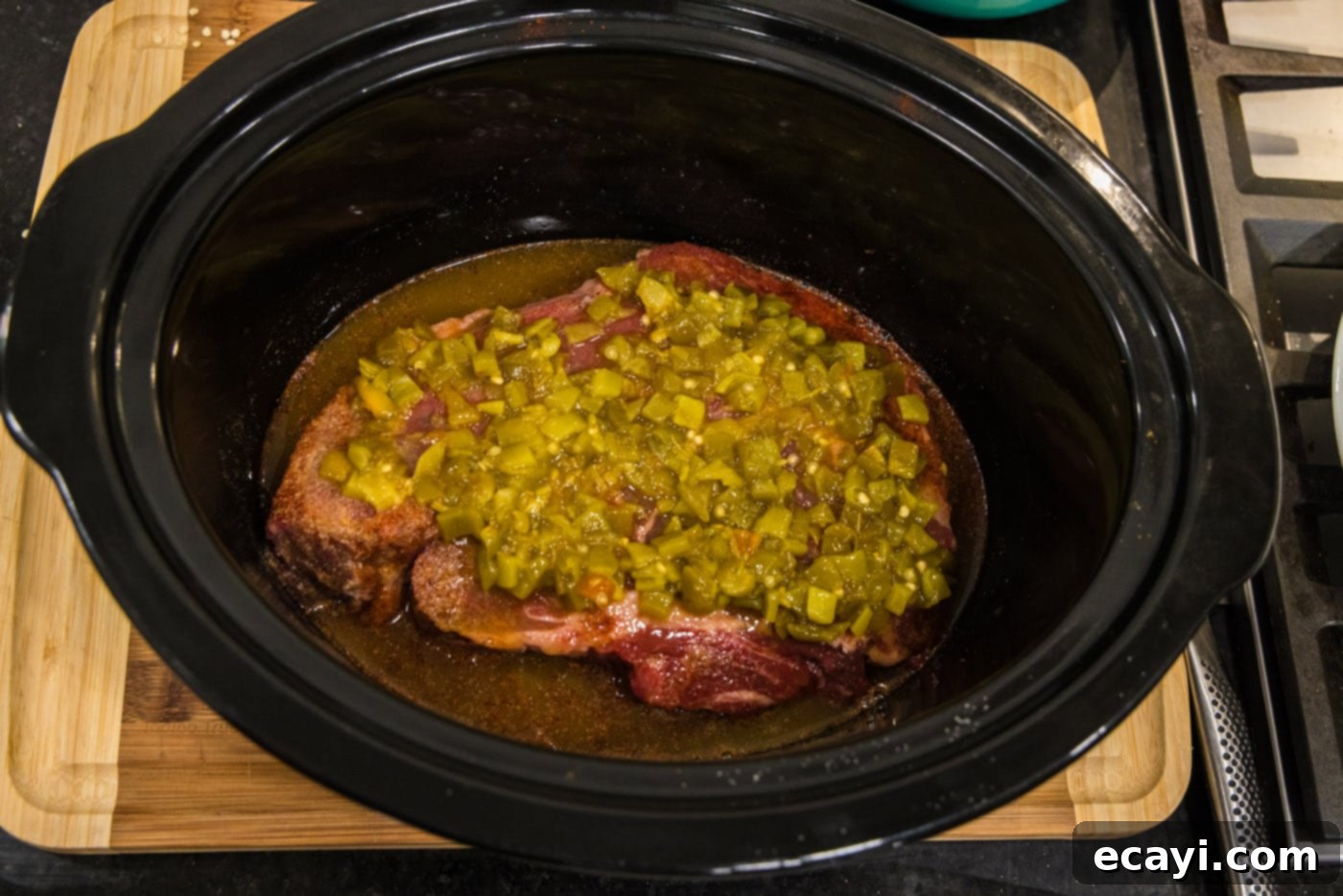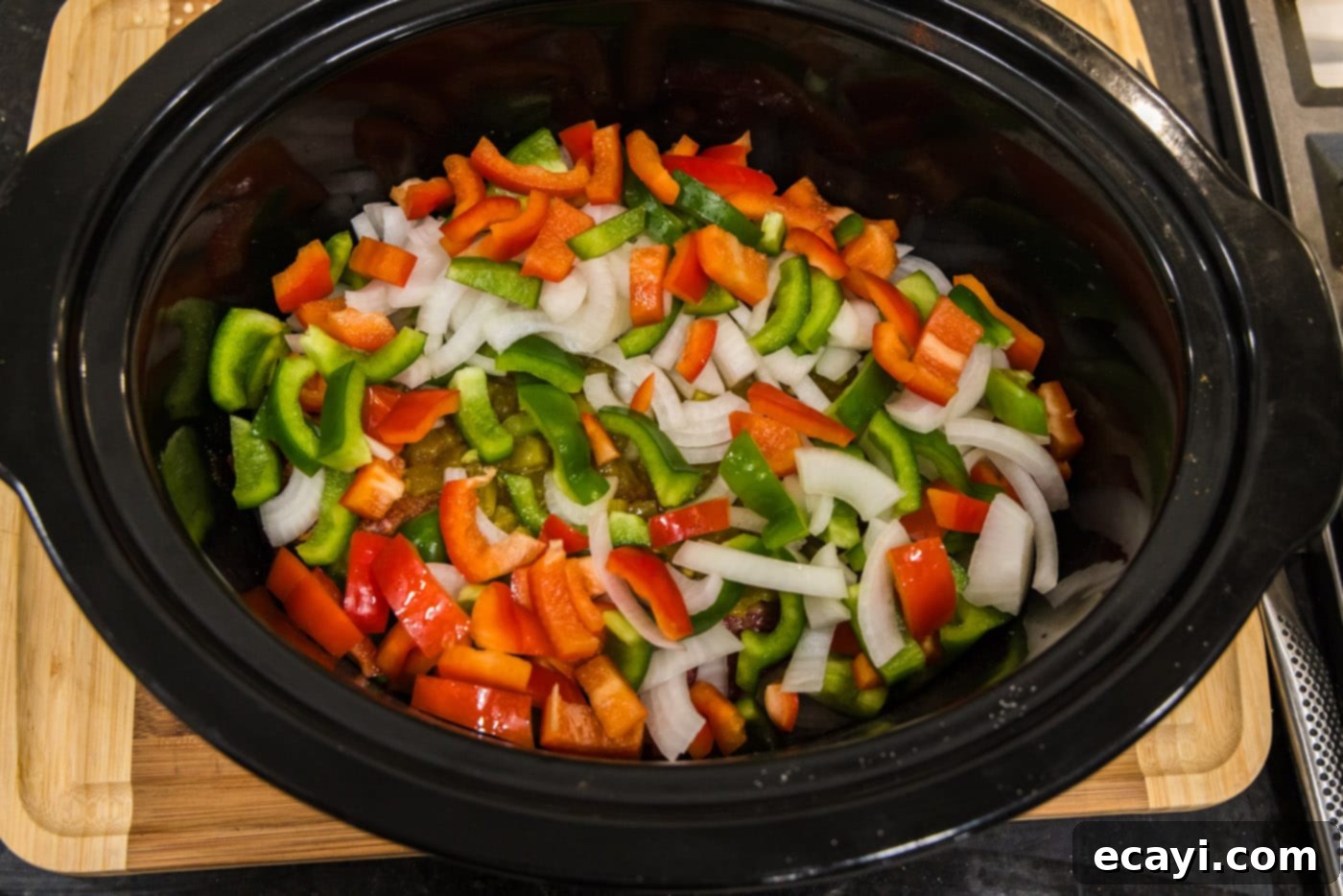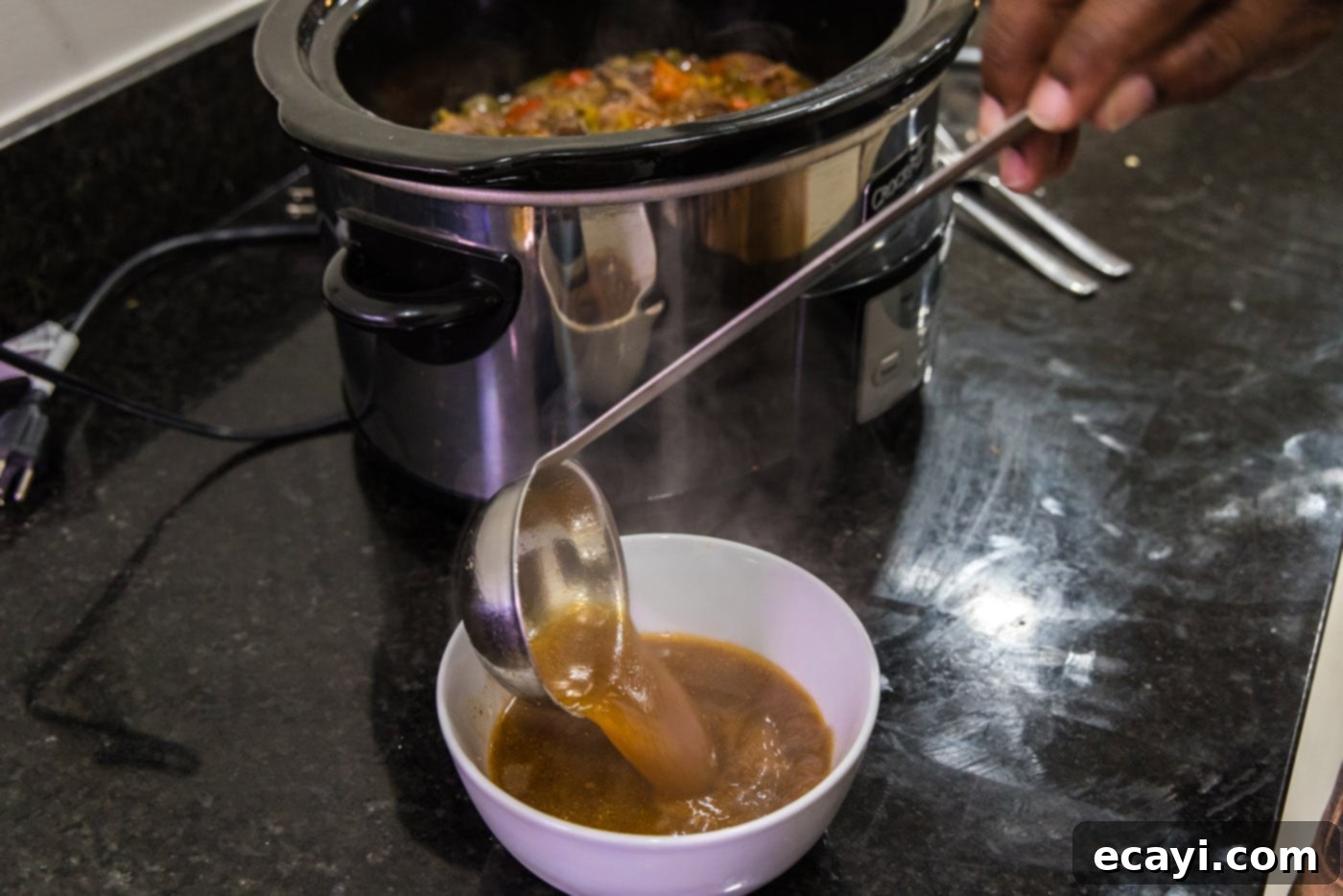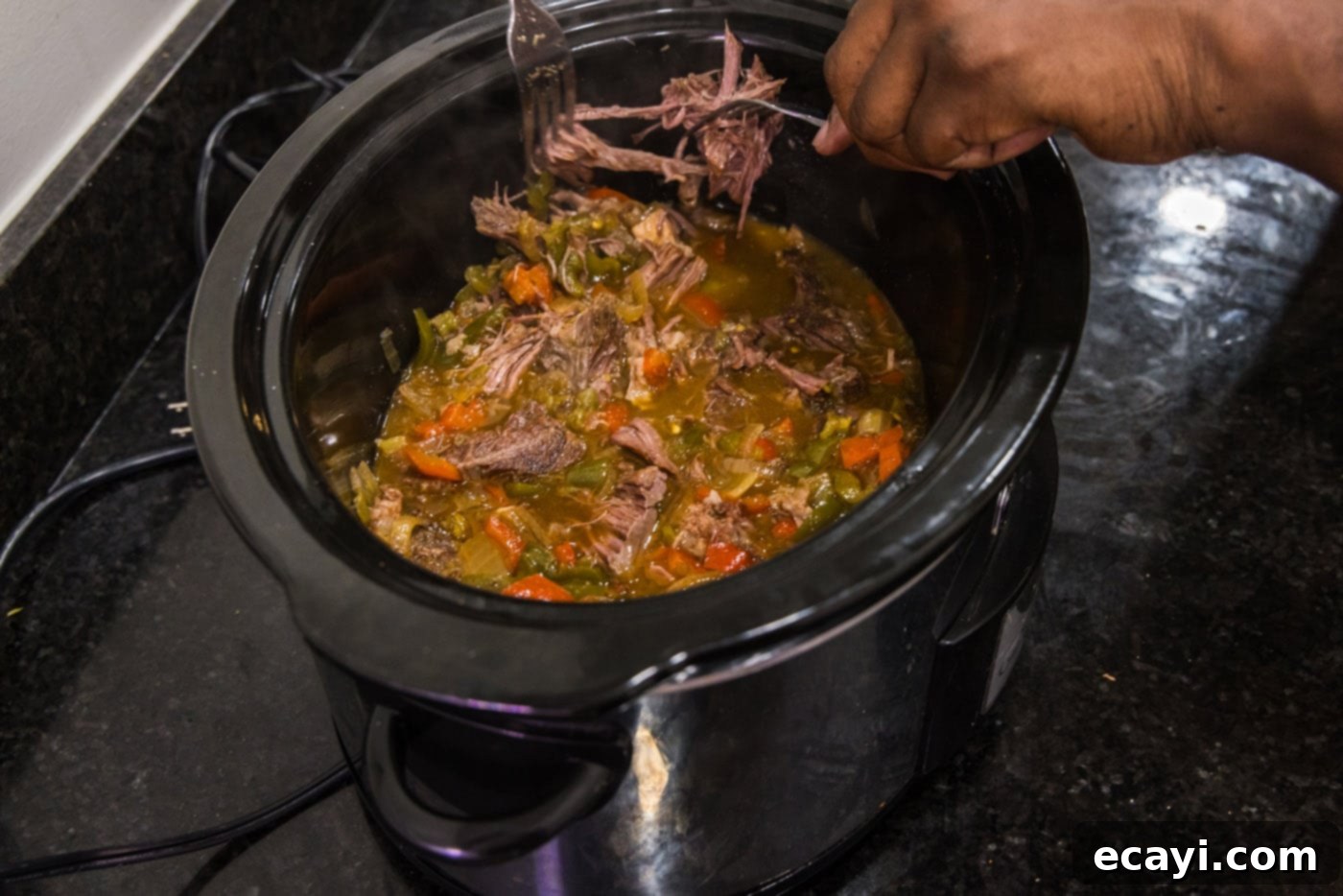Slow Cooker Beef Carnitas: Effortlessly Tender & Flavorful Shredded Beef Recipe
Prepare to savor the incredible flavors of tender, juicy beef carnitas, slow-cooked to perfection with a vibrant medley of bell peppers, aromatic onion, and a hint of green chiles. This “set it and forget it” recipe transforms a simple chuck roast into irresistibly shreddable beef, ready to be the star of your next meal. Whether tucked into warm tortillas, piled onto nachos, or served in a hearty bowl, these beef carnitas promise a burst of authentic, savory taste with minimal effort.
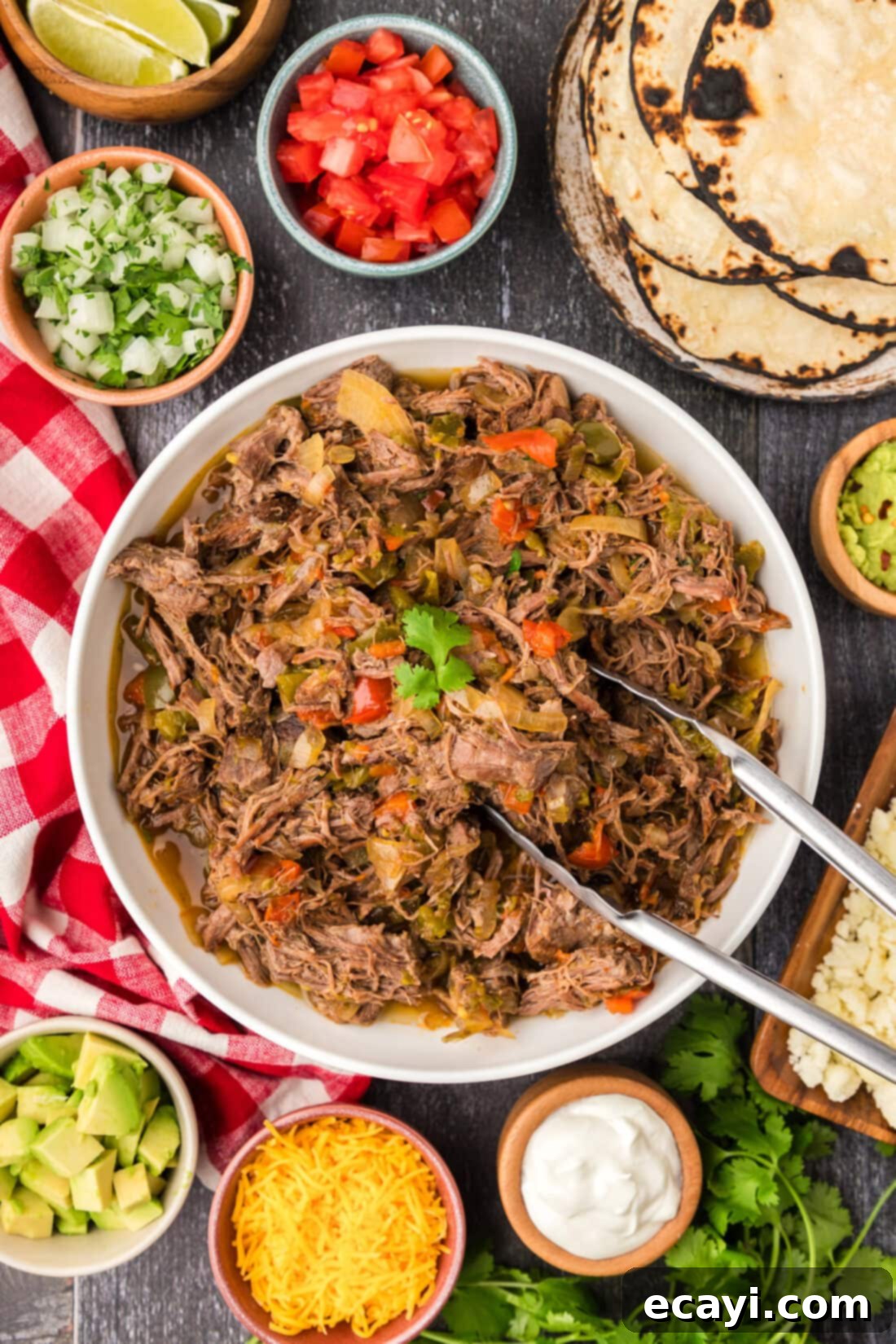
Why This Slow Cooker Beef Carnitas Recipe Will Become Your Favorite
This beef carnitas recipe truly excels in its simplicity and the depth of flavor it achieves. It’s a culinary dream for anyone seeking a hearty, satisfying meal without endless hours of hands-on cooking. The magic happens in your slow cooker, where a robust chuck roast simmers with a harmonious blend of vegetables and seasonings for 7-8 hours. This low-and-slow method is precisely what makes the beef incredibly tender, allowing it to easily shred with just two forks.
While the term “carnitas” traditionally refers to Mexican “little meats,” usually made from braised or roasted pork, our beef rendition is equally, if not more, enticing. We find that a well-marbled chuck roast, when cooked in this manner, yields a rich, succulent result that rivals its pork counterpart. The slow cooker method is particularly brilliant for busy weeknights or when entertaining, as it allows you to prep ahead and focus on your guests, knowing a delicious, comforting meal is steadily cooking itself. The blend of bell peppers, onion, and green chiles doesn’t just add flavor; it creates a fragrant broth that infuses every strand of beef with irresistible zest and moisture, ensuring each bite is a true delight.
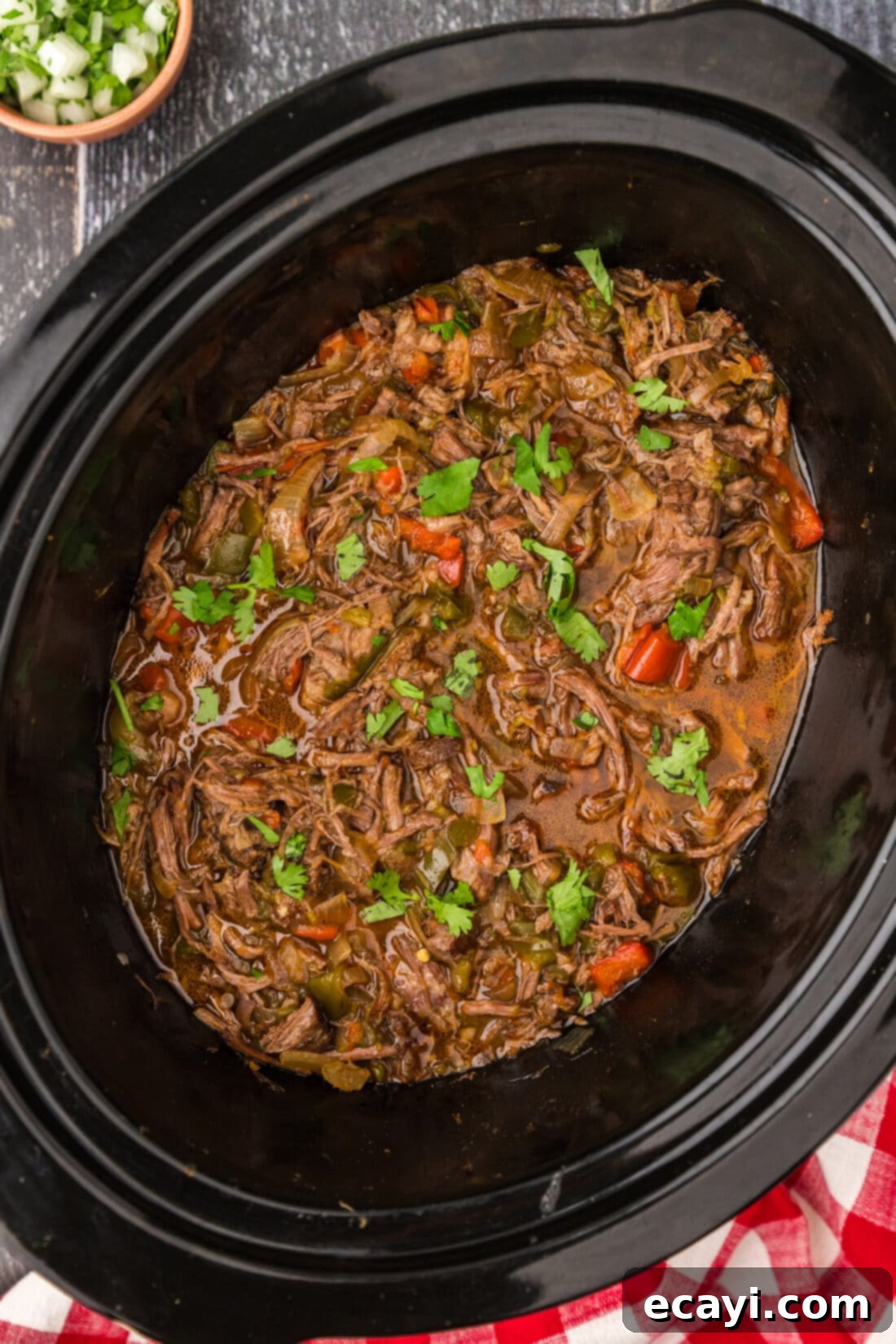
Essential Ingredients for Perfect Beef Carnitas
Crafting these mouthwatering slow cooker beef carnitas requires a few key ingredients that work together to create an explosion of flavor and an unbeatable texture. You’ll find a detailed list of all measurements, specific ingredients, and comprehensive instructions in the printable recipe card located at the very end of this post.
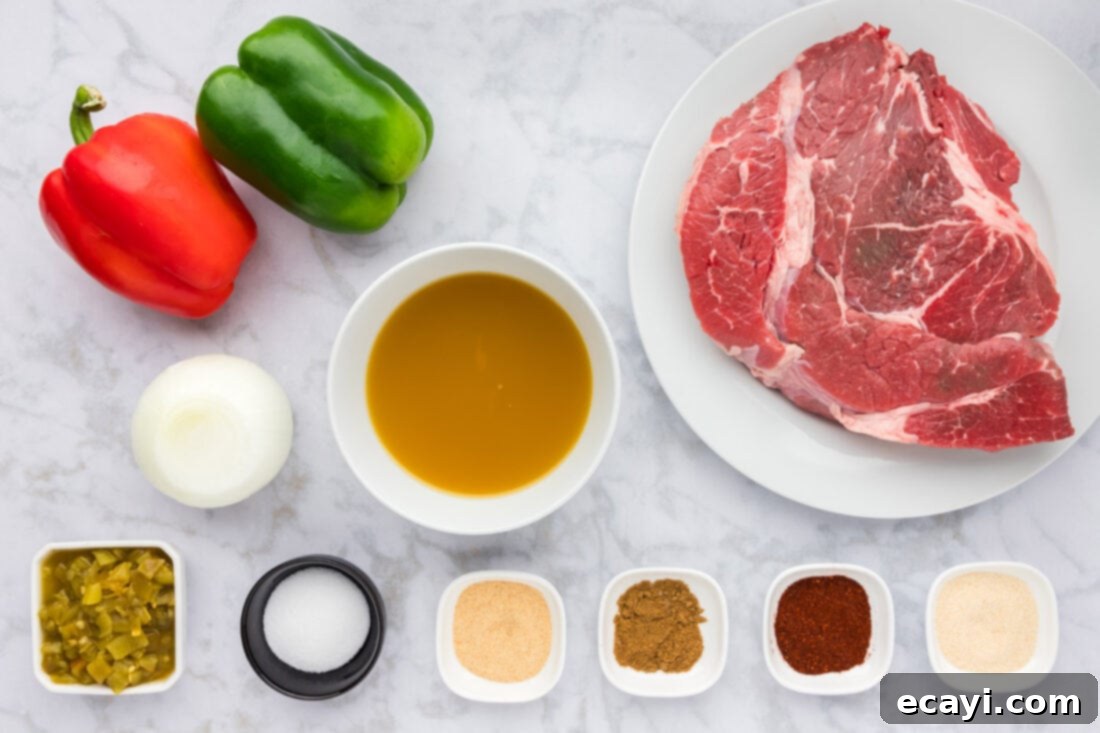
Ingredient Breakdown & Clever Substitutions
Understanding each component’s role in this recipe will help you achieve the best results and confidently make substitutions if needed:
BEEF – Our top recommendation for slow cooker beef carnitas is a high-quality chuck roast. This cut is perfect because its generous fat marbling breaks down beautifully during the long cooking process, resulting in incredibly tender, moist, and flavorful shredded beef. The fat renders, enriching the cooking liquid and contributing to the succulent texture. If chuck roast isn’t available, other well-marbled cuts like beef brisket or even a boneless beef short rib could work, though cooking times might vary slightly.
SEASONING – The spice blend is crucial for authentic flavor. We rely on a robust combination of garlic powder, onion powder, chili powder, ground cumin, and salt. These spices create a warm, earthy, and mildly savory base that complements the beef and vegetables perfectly. Feel free to customize this blend to your preference. For a different twist, consider using a good quality Cajun seasoning for a spicier kick, a smoky rib rub, or a versatile all-purpose seasoning for a convenient shortcut. Remember, good seasoning is key to lifting the entire dish.
PINEAPPLE JUICE – Don’t skip the pineapple juice! This secret ingredient is a game-changer for tenderizing the beef. Pineapple contains bromelain, an enzyme that naturally breaks down protein fibers, ensuring your beef becomes fall-apart tender. Rest assured, its flavor is incredibly subtle and won’t overpower the savory notes of the carnitas; it simply acts as a natural tenderizer and adds a hint of sweetness and acidity that brightens the dish without tasting overtly fruity.
CHILES – Diced green chiles are essential for adding a mild, earthy heat and a distinct Southwestern flavor profile. They contribute depth without being overly spicy. If you prefer a bit more heat, you can easily substitute them with chopped fresh jalapeño (remove seeds for less heat) or even a can of fire-roasted diced tomatoes with green chiles for an added layer of smoky flavor.
BELL PEPPERS & ONION – We use both red and green bell peppers, along with a medium onion, coarsely chopped. As they slow cook, these vegetables soften and release their natural sweetness and aromatic compounds into the beef, creating a rich, savory broth. The bell peppers add a beautiful pop of color and a subtle sweet crunch, while the onion forms the aromatic backbone of the dish. You can experiment with other colors of bell peppers or even add a poblano pepper for an additional layer of mild heat.
Step-by-Step: Crafting Irresistible Slow Cooker Beef Carnitas
These step-by-step photos and detailed instructions are provided to help you visualize the process of making this delicious recipe. For a complete printable version, including all precise measurements and cooking instructions, please Jump to Recipe at the bottom of this post.
- Prepare the Beef Roast: Begin by carefully trimming any large, excessive pieces of fat from your beef chuck roast. While some fat is vital for flavor and moisture, too much can make the final dish greasy. Aim for a good balance, leaving a reasonable amount of marbling and surface fat to render down and keep the beef succulent throughout the long cooking process.
- Season and Place in Slow Cooker: Place the trimmed chuck roast directly into the crock of your slow cooker. Generously sprinkle it on all sides with your chosen seasonings: garlic powder, onion powder, chili powder, ground cumin, and salt. Ensure an even coating for maximum flavor infusion.
PRO TIP – For quicker cooking and easier shredding later, you can cut the chuck roast into large, manageable chunks (about 2-3 inches) before placing it in the slow cooker and seasoning. This also allows for more surface area to be coated with spices and makes it simpler to remove any remaining excess fat that isn’t around the edges once cooked.

- Add Pineapple Juice: Evenly drizzle the pineapple juice over the seasoned roast. This magical ingredient will begin its tenderizing work, ensuring your beef becomes incredibly soft and juicy. You won’t taste the pineapple prominently; it simply enhances the texture.


- Layer with Vegetables: Next, distribute the diced green chiles evenly over the roast. Follow by adding the coarsely chopped onion and both the red and green bell peppers around and on top of the beef. These vegetables will slowly cook down, contributing moisture, sweetness, and depth to the final carnitas.


- Slow Cook to Perfection: Secure the lid on your slow cooker. Cook on the LOW setting for approximately 7-8 hours, or until the beef roast is exceptionally tender and easily pulls apart with a fork. The exact cooking time may vary slightly depending on your slow cooker and the size of your roast, so check for tenderness around the 7-hour mark.
- Drain and Reserve Juices: Once the beef is cooked, carefully spoon off any excess fat that has risen to the surface and discard it. This prevents the carnitas from being overly greasy. Next, gently remove most of the flavorful cooking juices from the slow cooker, setting them aside in a separate bowl. These juices are liquid gold – you might want to add some back in later if the shredded beef seems too dry.

- Shred the Beef: Using two forks, begin to shred the tender beef directly in the slow cooker. It should pull apart effortlessly. Once all the meat is shredded to your desired consistency, assess its moisture level. If you find the carnitas appear too dry, gradually stir in some of the reserved cooking juices until the beef reaches a perfectly moist and succulent texture. This ensures every bite is flavorful and never dry.

Frequently Asked Questions & Expert Tips for Beef Carnitas
Absolutely! Beef carnitas freeze exceptionally well, making this recipe perfect for meal prepping. To freeze, allow the cooked and shredded beef to cool completely. Then, transfer it to a large, freezer-safe ziptop bag or an airtight container. We highly recommend drizzling some of the reserved cooking juices over the beef before freezing; this helps maintain its moisture and flavor upon reheating. It can be frozen for up to 3 months. When you’re ready to enjoy, thaw it in the refrigerator overnight, then reheat it gently in the crockpot on low, or in a saucepan over medium-low heat on the stovetop until warmed through.
Storing leftovers is straightforward. Once cooled, place the beef carnitas in an airtight container and keep it in the refrigerator for up to 4 days. When reheating, a microwave works fine, or for best results, warm it on the stovetop over medium-low heat, adding a splash of the reserved juices (or a little broth) to keep it moist and tender.
Given that this is a slow cooker recipe, you’re inherently making it ahead of time by letting it cook for several hours. This makes it ideal for planning meals. If you want to take it an extra step further, you can prep all your ingredients the night before: chop the vegetables, measure out the spices, and have the roast ready. Then, in the morning, it’s just a matter of dumping everything into the crockpot, making your cooking day even quicker and more convenient.
While browning the beef before placing it in the slow cooker can add another layer of caramelized flavor, it is absolutely not necessary for this recipe. The long, slow cooking process ensures the beef becomes incredibly tender and flavorful on its own, absorbing all the aromatic spices and juices. Skipping this step saves time and makes the recipe even more “set-it-and-forget-it” friendly.
To achieve those desirable crispy edges typical of traditional carnitas, after shredding the beef, spread it out in a single layer on a baking sheet. You can then broil it in your oven for 5-10 minutes, or fry it in a hot skillet with a little oil, until the edges are nicely browned and crispy. This step adds a wonderful textural contrast to the tender shredded meat.
The beauty of carnitas lies in its versatility with toppings! Classic choices include freshly chopped cilantro, diced white onion, a squeeze of fresh lime juice, and a dash of your favorite hot sauce. Other fantastic additions are crumbled cotija cheese, a dollop of sour cream or Mexican crema, sliced avocado or homemade guacamole, and a vibrant pico de gallo or salsa verde. Don’t be afraid to get creative!
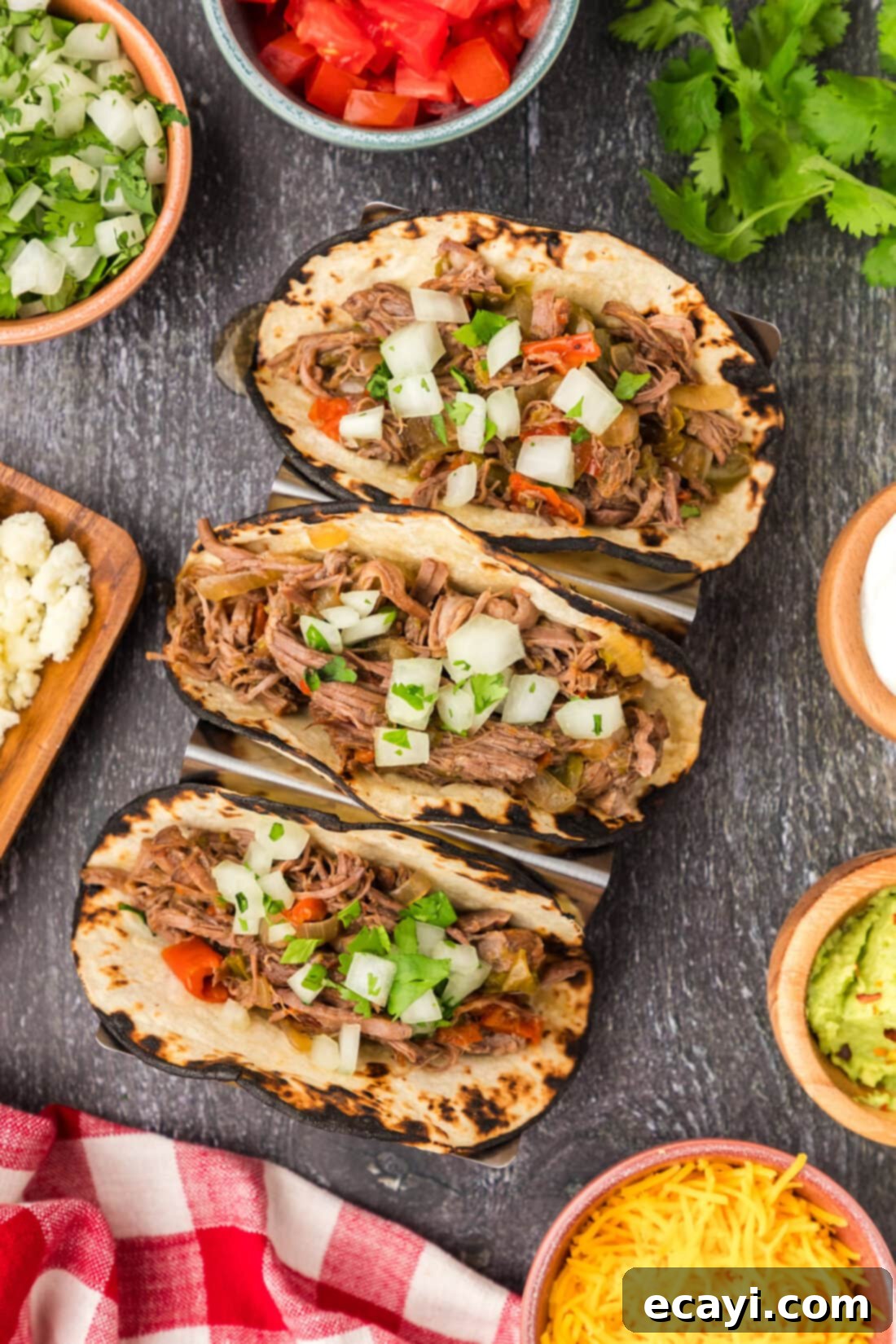
Creative Ways to Serve Your Delicious Beef Carnitas
Once your beef carnitas are perfectly shredded and infused with flavor, the possibilities for serving are endless! This versatile shredded beef can be the star of countless dishes. Pile your tender carnitas into your favorite “vehicle,” such as warm corn tortillas for classic tacos, or soft homemade flour tortillas for burritos. They are also phenomenal stuffed into burrito shells, rolled into enchiladas, or served as a hearty filling for quesadillas. For a lighter meal, create delicious bowls with rice and beans, or add them to fresh salads for a protein-packed punch. Don’t forget baked potatoes, where the savory beef contrasts beautifully with fluffy spuds. It’s even fantastic spread generously over a big plate of crispy nachos, loaded with cheese and all your favorite fixings.
Enhance the experience by pairing your beef carnitas with classic Mexican accompaniments like creamy guacamole, zesty salsa verde, or a vibrant restaurant-style salsa. A squeeze of fresh lime juice and a sprinkle of chopped cilantro are always welcome additions that brighten the flavors.
Perfect Pairings: What To Serve With Beef Carnitas
Complete your Mexican-inspired feast with these delicious side dishes that perfectly complement the rich flavors of beef carnitas:
- Classic Spanish Rice: A fluffy, flavorful rice dish seasoned with tomatoes and spices, offering a comforting and traditional accompaniment.
- Salsa Fresca (Pico de Gallo): A fresh, vibrant salsa made with diced tomatoes, onions, cilantro, and jalapeños, adding a burst of freshness and mild heat.
- Mexican Corn (Esquites): Creamy, cheesy, and slightly spicy corn prepared with mayonnaise, cotija cheese, chili powder, and lime juice – an irresistible side.
- Mexican Inspired Sangria: A refreshing and fruity beverage, perfect for washing down your savory carnitas and adding a festive touch to your meal.
I love to bake and cook and share my kitchen experience with all of you! Remembering to come back each day can be tough, that’s why I offer a convenient newsletter every time a new recipe posts. Simply subscribe and start receiving your free daily recipes!
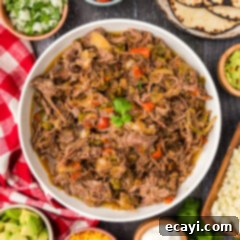
Beef Carnitas
IMPORTANT – There are often Frequently Asked Questions within the blog post that you may find helpful. Simply scroll back up to read them!
Print It
Pin It
Rate It
Save ItSaved!
Ingredients
- 3 pounds beef chuck roast
- 1 large red bell pepper coarsely chopped
- 1 large green bell pepper coarsely chopped
- 1 medium onion coarsely chopped
- 4 ounces diced green chiles 1 can
- 1 Tablespoon garlic powder
- 1 Tablespoon onion powder
- 1 Tablespoon chili powder
- 1 Tablespoon ground cumin
- 1 Tablespoon salt
- 1 ½ cups pineapple juice
Things You’ll Need
-
6 qt Crockpot
Before You Begin
- We use garlic powder, onion powder, chili powder, cumin, and salt but feel free to substitute with your favorite spice blend. Cajun seasoning, rib rub, or all purpose seasoning are other great options.
- The pineapple juice helps break down the meat as it cooks leaving you with tender, juicy beef. You won’t even realize pineapple juice is added flavor-wise.
- Green chiles are a flavor component. You can substitute with chopped jalapeno if desired.
Instructions
-
Trim any excess fat from the roast. Don’t completely get rid of all the fat, leaving some helps with the flavor!
-
Place roast in the crock of the slow cooker. Sprinkle with garlic powder, onion powder, chili powder, ground cumin, and salt.
TIP – Instead of placing the roast in whole, you can cut it into large chunks. This will also make it easier for you to remove any excess fat that is not around the edges of the roast.
-
Drizzle pineapple juice over the seasonings on the roast.
-
Cover roast with diced green chiles, then add the coarsely chopped onion and both bell peppers.
-
Cover slow cooker and cook on low for 7-8 hours, or until roast is very tender.
-
Spoon off any excess fat and discard. Remove most of the juice and set the juices aside (in case you need to add some back in).
-
Use two forks to shred the meat. When finished, if you feel it is too dry, you can add some of the reserved juices back in.
Expert Tips & FAQs
- Pile your beef carnitas into your vehicle of choice such as corn or flour tortillas, burrito shells, enchiladas, bowls, salads, or baked potatoes. It’s even fantastic over a big plate of nachos.
- Store cooled leftovers in an air-tight container kept in the refrigerator for up to 4 days. Reheat in the microwave or on the stovetop over medium-low heat with some of the juices.
- Freezing – place the cooled beef in a large ziptop bag and freeze for up to 3 months. I would recommend drizzling some of the juices over the beef before freezing. Thaw in the refrigerator overnight and reheat in the crockpot or in a saucepan over medium-low heat on the stovetop.
- You can prep all the ingredients the night before so it’s even quicker to dump them into the crockpot when the time comes.
Nutrition
The recipes on this blog are tested with a conventional gas oven and gas stovetop. It’s important to note that some ovens, especially as they age, can cook and bake inconsistently. Using an inexpensive oven thermometer can assure you that your oven is truly heating to the proper temperature. If you use a toaster oven or countertop oven, please keep in mind that they may not distribute heat the same as a conventional full sized oven and you may need to adjust your cooking/baking times. In the case of recipes made with a pressure cooker, air fryer, slow cooker, or other appliance, a link to the appliances we use is listed within each respective recipe. For baking recipes where measurements are given by weight, please note that results may not be the same if cups are used instead, and we can’t guarantee success with that method.
